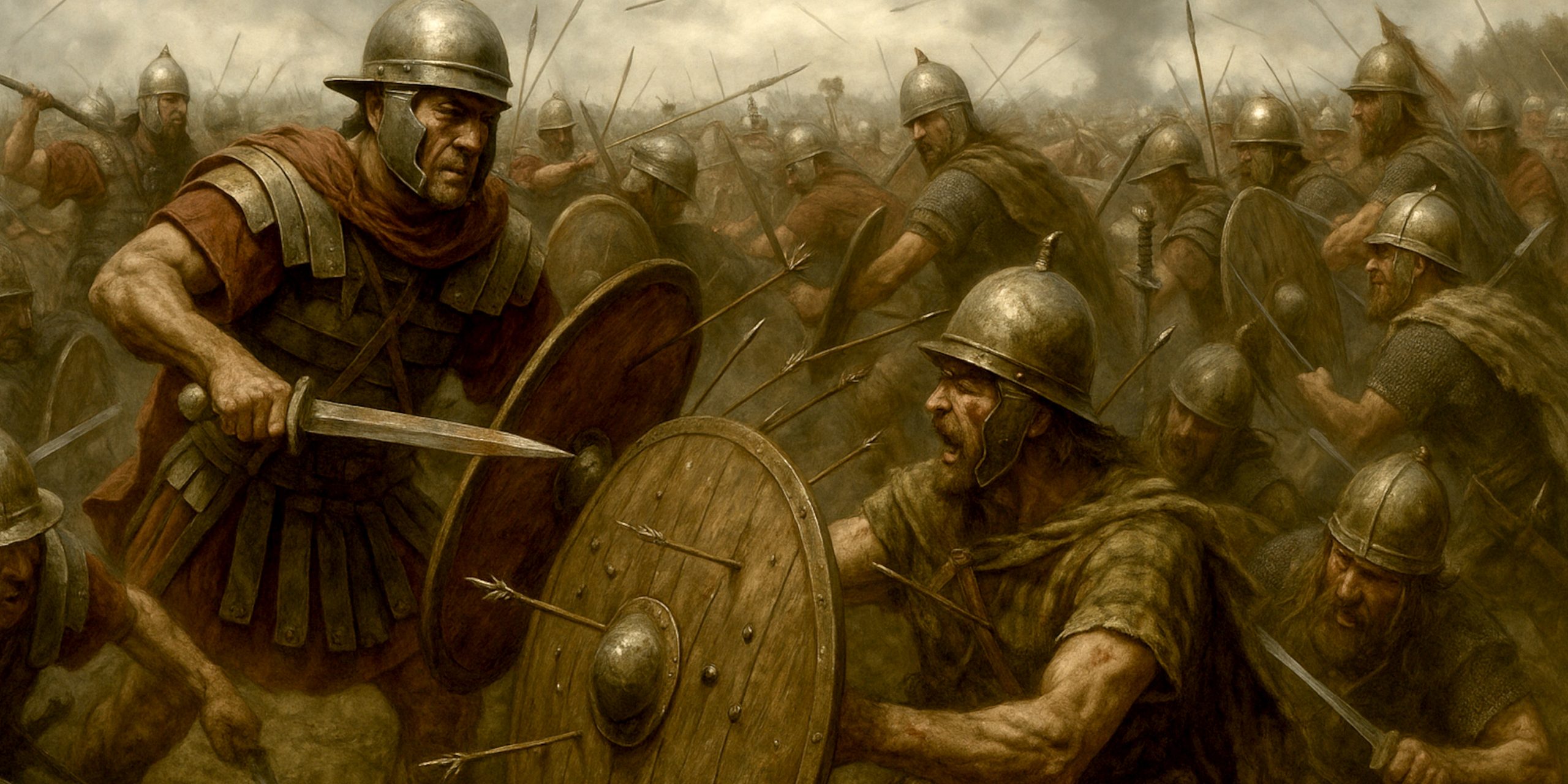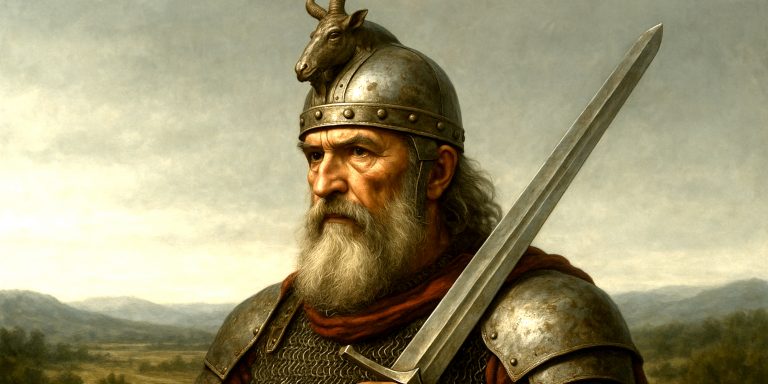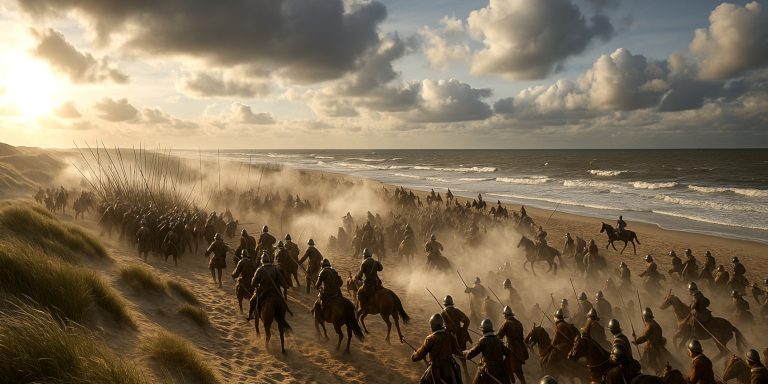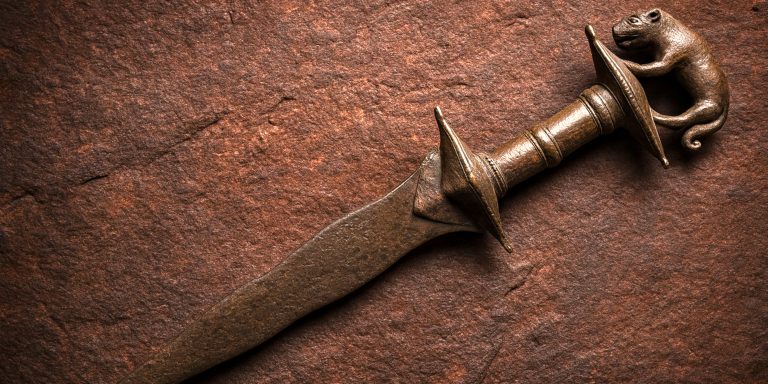
The Battle of the Sabis, fought in 57 BC near a river now identified as either the Selle or the Sambre, was one of Julius Caesar’s most perilous confrontations during the Gallic Wars. His Roman legions faced a sudden, well-organised ambush by the Nervii, one of the most determined Belgic tribes. Despite being caught off guard during the construction of their camp, the Romans managed to rally and secure a hard-fought victory.
Background
Julius Caesar’s campaign in Belgica aimed to neutralise Gallic resistance after securing Roman control over much of Gaul. The Nervii, along with the Atrebates and Viromandui, saw Roman expansion as an existential threat. Rather than wait for a siege or prolonged engagement, they planned an ambush that would exploit the Romans’ overconfidence and logistical distractions.
Forces
| Faction | Estimated Troops | Notable Commanders |
|---|---|---|
| Roman Republic | ~45,000 (including auxiliaries and camp followers) | Gaius Julius Caesar, Titus Labienus |
| Nervii Coalition (incl. Atrebates & Viromandui) | ~60,000 | Unknown tribal chieftains |
The Nervii relied on a sudden charge and close combat to overwhelm the Romans before their disciplined formations could be established. The Roman forces were seasoned but temporarily vulnerable due to their dispersed marching columns and camp preparations.
Arms and Armour
Roman Legions
- Weapons:
- Gladius Hispaniensis: Short thrusting sword ideal for close combat
- Pilum: Heavy javelin designed to penetrate shields and armour
- Armour:
- Lorica hamata (chain mail)
- Scutum (large curved rectangular shield)
- Montefortino-style helmets
- Tactics:
- Cohort formations with supporting cavalry and auxiliaries
- Fortified camps used as both defensive redoubts and operational hubs
Nervii and Allies
- Weapons:
- Long thrusting spears and javelins
- Iron swords, often of La Tène design
- Armour:
- Minimal; some chieftains may have worn chainmail or leather
- Oval or circular wooden shields, often painted or decorated
- Tactics:
- Rapid ambush using terrain and riverbank concealment
- Melee-focused charges aiming to disrupt Roman cohesion
Battle Timeline
| Timeframe | Event |
|---|---|
| Morning | Roman legions approach the Sabis River, unaware of nearby enemy presence. Marching formations are stretched, and camp construction begins. |
| Midday | Nervii, hidden in woods and riverbanks, launch a surprise mass charge against the dispersed Romans. |
| Early Afternoon | Roman lines begin to collapse in places. Caesar personally enters the fray, rallying troops. The 10th Legion under Labienus secures a key bridgehead. |
| Later Afternoon | The Roman cavalry and reserves, along with returning foraging parties, rejoin the battle and stabilise positions. |
| Evening | The Nervii are repelled after fierce hand-to-hand combat. Roman victory declared, but with significant casualties. |
Archaeology
No definitive battlefield site has been confirmed, though sites along the Sambre and Selle rivers in modern Belgium have yielded Iron Age and Roman artefacts. Finds include:
- Fragments of Roman chainmail
- Belgic-style spearheads and shield bosses
- Remains of temporary Roman fortifications and ditches
- Scattered cremation sites possibly linked to post-battle burials
The lack of heavy fortification traces supports Caesar’s claim that the Romans were attacked before camp construction was complete.
Contemporary Quotes
Julius Caesar, Commentarii de Bello Gallico, Book 2:
“The enemy poured down from all sides, so suddenly and so quickly, that time was not allowed to make any arrangements or to put on the military insignia.”
“The bravery of the Nervii was so great that they passed through the pila without flinching and attacked the legionaries in the rear while others were still in front.”
These remarks, though self-serving, offer a window into both the chaos of the engagement and the intensity of Nervii resistance.
Legacy
The Battle of the Sabis stands out not just for its drama but for how close Caesar came to defeat. It underscored the tenacity of the Belgic tribes and the adaptability of Roman military doctrine. The Nervii were nearly annihilated, yet Caesar praised their courage in defeat.
Modern historians often cite this battle as a prime example of Roman command resilience under pressure. It also reveals Caesar’s skill in narrative control—turning a near disaster into a tale of valour and Roman superiority.
Related Topics
- Caesar’s Gallic Wars: Strategic Overview
- Roman Camp Construction Techniques
- Belgic Tribes: Warfare and Society
- Roman Battlefield Medicine and Casualty Care
Watch the documentary:



